Pottery
Pottery as type fossil is kind of a typical mark for any archaeological excavation in the Ancient Near East and beyond. Vessel shapes and decoration are important hints on a certain area or period of time.
From the excavations at Isin, the Institute brought back a number of pottery shards for teaching and research purposes. The exhibition shows pottery from the Islamic period (c. 9th-14th century). Noticeable is the variety in production techniques, colours and decoration.
In the course of the excavations at Isin, pottery of the Islamic period was collected at various spots and displays different categories: unglazed ware, underglaze painted ware and fritware. The range of glazed and fritwares covers a timespan from the 11th to the 14th century AD.
Soft stone vessels
Soft-stone or steatite vessels have so far not been investigated in detail for the Islamic period. The compact small bowls or basins mostly have a straight-sided wall and at times short lugs as handles. The decoration often shows a chiselled dot-in-circle motif that is arranged in horizontal and vertical rows around the body of the vessel.
Unglazed kitchenware
Unglazed kitchenware always forms the bulk of excavated ceramic material but detailed studies are still missing for most regions and periods in the Islamic world. This desideratum may be explained by their longevity of production and the problems in distinguishing them clearly from pre-Islamic traditions on the one hand; on the other, the strong focus on the Islamic glazed wares in research is to blame as well. However, unglazed wares raise some interesting issues: they are handmade and a smoothening slip is partially still visible. Similar pieces with impressed spiral and circle motifs have been noted at different sites in Iraq, found in late Sassanian to Islamic deposits (c. 500-800 CE).
The fragments belonged to big storage jars, where the motif was impressed in a horizontal row around the belly of the vessel with multiple handles and a rounded base. As only one and the same spiral motif has been noted on one vessel, although several variations were in use, the question arose whether the impression really just stands for a decoration or whether it could not also imply a workshop mark, or a possession’s mark or some content indication. The fragments shown here with incised horizontal and wavy lines equally belonged to big storge jars that were also common in pre-Islamic periods. The incised motifs are usually placed on the neck, shoulder and upper body parts of the jars.
Underglaze painted ware
The shards are examples of underglaze painted ware, a technique that developed in 12th century Egypt or Iran and spread quickly to the Syro-Mesopotamian region. The metallic pigments (chromite for black, ferric oxide for brown and cobalt ore for blue) for the coloured painting were made into a suspension with water, fine clay and a binder and then painted directly on the biscuit-fired body before the piece was covered either with a transparent or opacified (copper oxide for green-turquoise) alkaline glaze.
While the painted designs show a wide range of motifs, the clay fabric is mostly of a very homogenous nature: it is of a pale yellow colour, fine, with very few tiny calcareous inclusions and quite porous resembling the “Basra” clay of earlier periods although this could only be differentiated with certainty by petrographic and chemical analysis. The same applies to the different fritware traditions and stages of development in pottery production in the Medieval Islamic period.
Fritware
Islamic potters were not only inventive in various glazing techniques but also concerning body composition, namely fritware (or stonepaste) that came to maturity in the second half of the 11th century and appears in the course of the following century at different locations along the Middle Euphrates, and as far as Central Iran. It is composed of crushed quartz, glass frit and small amounts of a special white clay. Our information on fritware is not only derived from petrographic-chemical analysis of fragments, but also the lucky survival of a manuscript of c. 1300, from a family of famous potters. It thus gives us first-hand information on practiced pottery techniques. The main attraction of fritware is its final pure white fabric that allows for delicate painting without the need to cover the clay body with a white base coat through slipping.
The shape of the complete bowl with footring, a flaring and then slightly tapered wall with a broad, flat rim everted to both sides forming a T-shape, is very typical of plain and underglaze painted Iranian and Syrian fritwares of the 13th-14th century. The five small body and footring fragments belonged maybe to a similar shaped bowl. Its black underglaze painted design shows a bunch of three floral or palm-tree-like motifs with a background of a loosely arranged arabesque motif. The footring fragment with a trellis pattern and emphasized dotted intersection points finds its parallel in the bottom of a waster from Raqqa; the chessboard-like pattern occurs in different variations in Syria and Iran in the 12th-13th century. The small and thin rim fragments possibly formed a conical small bowl with a slightly tapering rim. Typical for underglaze painted bowls is the black painted rim and the freely painted leaves and stems, reminiscent of a water-weed. These motifs were also combined with inscriptions while figural motifs seem less common.


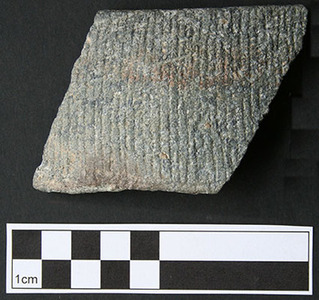 Fragment of soft-stone or steatite vessel. The fine fluting seen on this fragment was also recorded for a similar piece from Tell Abū Sarīfa of the 9th-10th century.
Fragment of soft-stone or steatite vessel. The fine fluting seen on this fragment was also recorded for a similar piece from Tell Abū Sarīfa of the 9th-10th century.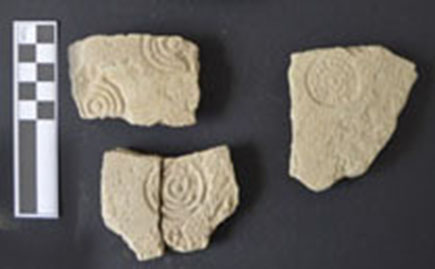 Unglazed wares: the impressed fragments are handmade and a smoothening slip is partially still visible.
Unglazed wares: the impressed fragments are handmade and a smoothening slip is partially still visible.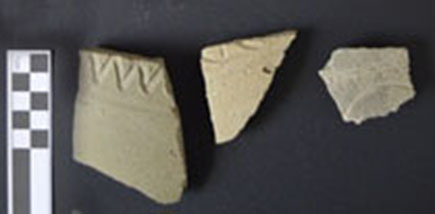 The fragments with incised horizontal and wavy lines belonged to big storage vessels.
The fragments with incised horizontal and wavy lines belonged to big storage vessels.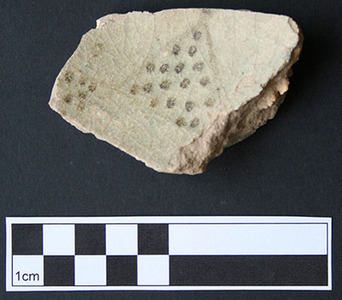 The dotted triangle also occurs on the interior bottom side of a lustre painted fritware bowl of the so-called “Raqqa-Ware” of the 12th-13th century.
The dotted triangle also occurs on the interior bottom side of a lustre painted fritware bowl of the so-called “Raqqa-Ware” of the 12th-13th century.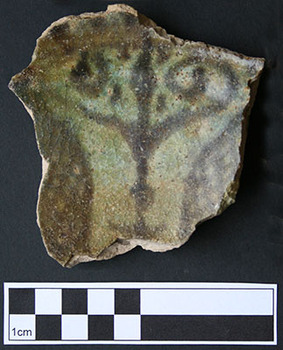 The fragment with a palmette flanked by two semi-circular forms filled with a trellis pattern was overfired, which explains the washed-out dull appearance. The palmette seems to recall the abstract stucco panels from Samarra (style One / style C). It reminds of the palmette-lotus motif (tree of life) encountered in several variations and endless new compositions from the ancient world up to modern times.
The fragment with a palmette flanked by two semi-circular forms filled with a trellis pattern was overfired, which explains the washed-out dull appearance. The palmette seems to recall the abstract stucco panels from Samarra (style One / style C). It reminds of the palmette-lotus motif (tree of life) encountered in several variations and endless new compositions from the ancient world up to modern times.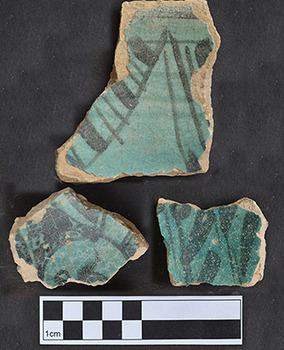 The group of green underglaze painted shards also seems to stand in the tradition of Raqqa Ware, but might be of the later Turkmen period (14th-15th century).
The group of green underglaze painted shards also seems to stand in the tradition of Raqqa Ware, but might be of the later Turkmen period (14th-15th century).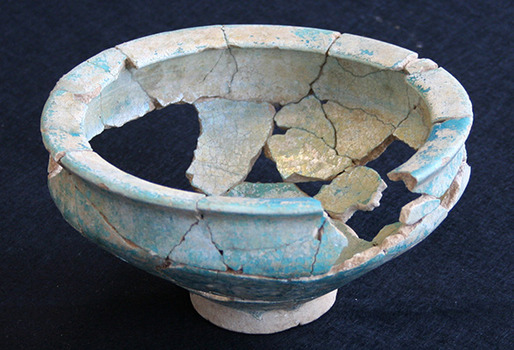 The shape of the complete bowl with footring, a flaring and then slightly tapered wall with a broad, flat rim everted to both sides forming a T-shape, is very typical of plain and underglaze painted Iranian and Syrian fritwares of the 13th-14th century.
The shape of the complete bowl with footring, a flaring and then slightly tapered wall with a broad, flat rim everted to both sides forming a T-shape, is very typical of plain and underglaze painted Iranian and Syrian fritwares of the 13th-14th century.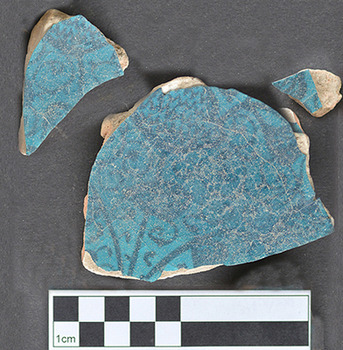 The three small body and footring fragments belonged maybe to a bowl similarly shaped as the one before. Its black underglaze painted design shows a bunch of three floral or palm-tree-like motifs with a background of a loosely arranged arabesque motif.
The three small body and footring fragments belonged maybe to a bowl similarly shaped as the one before. Its black underglaze painted design shows a bunch of three floral or palm-tree-like motifs with a background of a loosely arranged arabesque motif.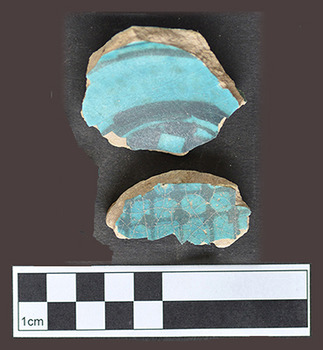 The chessboard-like pattern (above) occurs in different variations in Syria and Iran in the 12th-13th century (cf. Watson 2004: 295 K.6, 336 N.4.); the footring fragment with a trellis pattern and emphasized dotted intersection points (below) finds its parallel in the bottom of a waster from Raqqa (Jenkins 2006: S. 82, W85).
The chessboard-like pattern (above) occurs in different variations in Syria and Iran in the 12th-13th century (cf. Watson 2004: 295 K.6, 336 N.4.); the footring fragment with a trellis pattern and emphasized dotted intersection points (below) finds its parallel in the bottom of a waster from Raqqa (Jenkins 2006: S. 82, W85).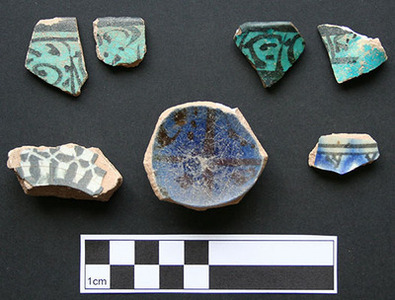 The small and thin rim fragments possibly formed a conical small bowl with a slightly tapering rim. Typical for underglaze painted bowls is the black painted rim and the freely painted leaves and stems, reminiscent of a water-weed. These motifs were also combined with inscriptions while figural motifs seem less common.
The small and thin rim fragments possibly formed a conical small bowl with a slightly tapering rim. Typical for underglaze painted bowls is the black painted rim and the freely painted leaves and stems, reminiscent of a water-weed. These motifs were also combined with inscriptions while figural motifs seem less common.